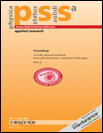The role of inter- and intraparticle transport for the microwave photoresponse in nanocrystalline semiconductors
Abstract
The photoinduced change of electrical conductivity and dielectric function were investigated in porous silicon and porous TiO2 by means of Complex Transient Microwave Photoconductivity Method. In porous TiO2, the photoexcitation leads to the increase of the dielectric function. The amplitude of this increase depends strongly on the size of the nanoparticles. The sign of the photoinduced change of the dielectric function is negative for mesoporous silicon and positive for nanoporous silicon. The photoinduced increase of the dielectric function in porous TiO2 is explained by the spatial separation of photoexcited charge carriers inside one nanoparticle while the interparticle transitions have very small probability during one microwave half period. In porous silicon, the confinement of charge carriers depends on the porosity. Therefore, the positive photoinduced change of the dielectric function is observed only in nanoporous silicon where most of photoexcited carriers are strongly localized.




